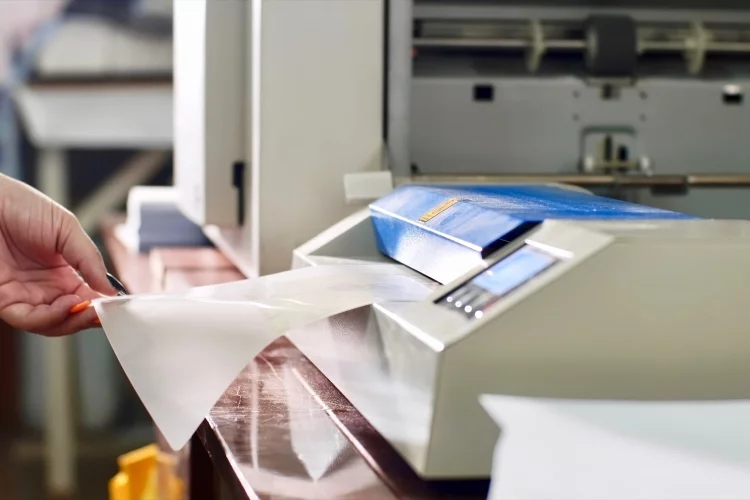by Lucas Lee
There are so many things we can do at home without the need to go to a professional. One of these things is laminating paper.
Contents
Laminating paper is One of the best ways to protect the longevity of the paper. The most interesting part of it all is that you do not even need to have a laminating machine at home! Yes, this might sound like wishful thinking. However, it is something you can do provided you have the necessary tools.
In this guide, we will cover a couple of methods that you can follow to help you successfully laminate paper in the comfort of home.

Laminating simply means covering materials in different layers. These layers serve to increase the strength of the material as well as offer protection.
For instance, there are books with very thick layers at the front and back. These layers protect the book from being destroyed by water oil or even losing its rigidity through multiple uses over time.
There are two ways to laminate at home. We have:
1. Laminating with a machine.
2. Laminating without a machine.
They are also called laminators.
This is a very simple process when you have a machine at home. It is also the best and fastest way to laminate your documents. However, to do this, you need to buy a laminator.
NOTE: Before you can use a laminating machine or laminator, you need a laminating film/pouch.
A laminating film or pouch is a nylon layer you add on paper/document. Laminating films come in different sizes. There are films for laminating small ID cards. There are also film big enough for laminating large certificates.
Here are the steps involved in using a laminator:
Start the process again by switching on the red light and reinserting the paper into the machine. Wait until all the paper has completely passed through the machine. If the result does not look as crisp as you want, you might want to rerun it through the laminator.
As you can see from the above step, laminating with a machine is a very much easy task. But, we don't all have a laminating machine at home. Fortunately, there are some ways you could still get around to laminating your paper or documents.
You should note that all these methods are not as efficient compared to using a laminator.

This is the most common way of laminating paper or books at home. You might already even know this process.
The steps involved in this method are as follows:
Cons of using Carton Sealing Tape
- There Is a need for a lot of tapes to seal the paper or book. This means that you cannot do this method unless you have enough sealing tape.
- Air bubbles might form in between the taped area. When this happens, you can simply run a credit card repeatedly over it. This should push away most of the bubbles
This is an efficient way of laminating paper at home. It is a very cheap process as you don't need to use lots of tapes to get the work done. It is also very efficient compared to simply taping your documents or book.
This process involves the use of self-adhesive sheets. They come in different models. Some are very solid and thick while others are not as durable.
TIP: While shopping for self-adhesive sheets, you want to shop for the ones that have a very solid feel on touch. So, what are the process involved in using self-adhesive sheets:

Everyone thinks laminating film or pouches only work with a laminating machine. Well, not really! All they need is a heat source, and that is what a laminating machine provides. Substituting other heat sources would also work.
There are only two things you need in this method:
- Household Iron
- Laminating film or pouch
- A towel
The steps involved are very similar to the steps you follow if you own a laminating machine.
This is another method of laminating paper using Carton Sealing Tape. It is only suitable if you feel the previous method is not suitable for your document.
Unlike the previous method where you simply run the tape from edge to edge without break in the line or chain, you have to allow breaks in the chain in this method. Here are the process involved:
Cons
- The finished work might look shabby because the tapes overlap.
As with every procedure that involves heat, there is always a danger that accompanies it. It does no matter how experienced you are using a laminator, there are always steps you can take to avoid the risk of any injury.
That said, the following are tips you need to know to help you stay safe at home:
This is very important if you are just buying your first laminating machine. As earlier stated, the easiest way to laminate is with a machine. Although it is an expensive process, it is simply the best.
There is a reason why every electronic device or gadget comes with an instruction manual. It is to help you better understand how to handle the device without danger. You can never go wrong following the advice of the device's manufacturer.
It is a machine that generates heat. There is just no point in having it plugged in or switched on when you don't plan on using it.
There are different ways to do this. You can briefly feel the heat by dangling your hands above the roller. If you feel it is too hot, you should immediately switch it off and allow it to cool down. Then start the whole process again when the temperature is just right.
NOTE: The manual should also contain instructions about the appropriate temperature to begin laminating.
Every method all points to one thing, there is only one best and efficient way to laminate your documents at home. That method is simply with the use of a laminating machine. Yes, they are expensive, but the finished work makes them worth all the money!
Other methods work too and will help protect your documents.

About Lucas Lee
Lucas Lee was raised outside the city of Livermore, in the legendary Bay Area of North California. Lucas considers his family and researches to be most important to him. If he isn’t hanging out with his loved ones, you can almost always find him around his sweet little garden of fruits right in the backyard of his lovely home.
 |
 |
 |
 |